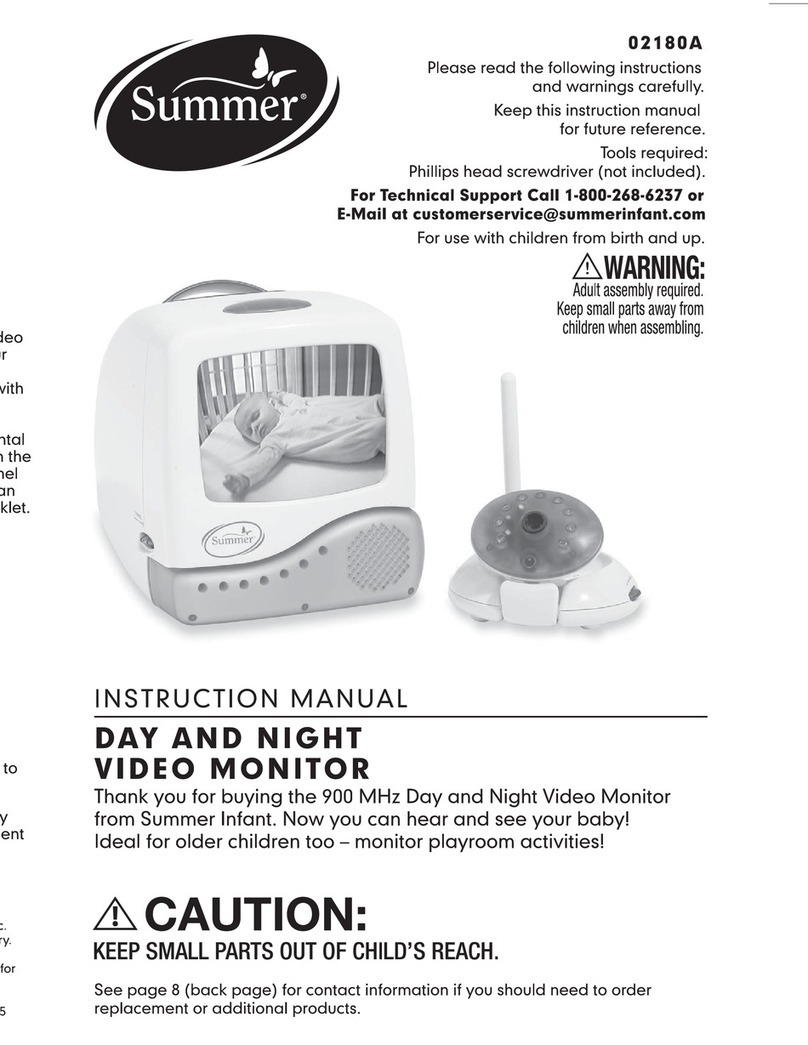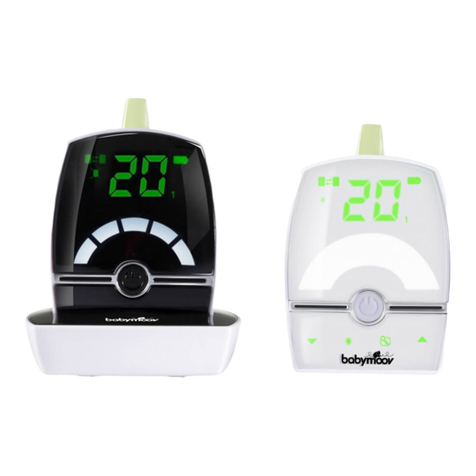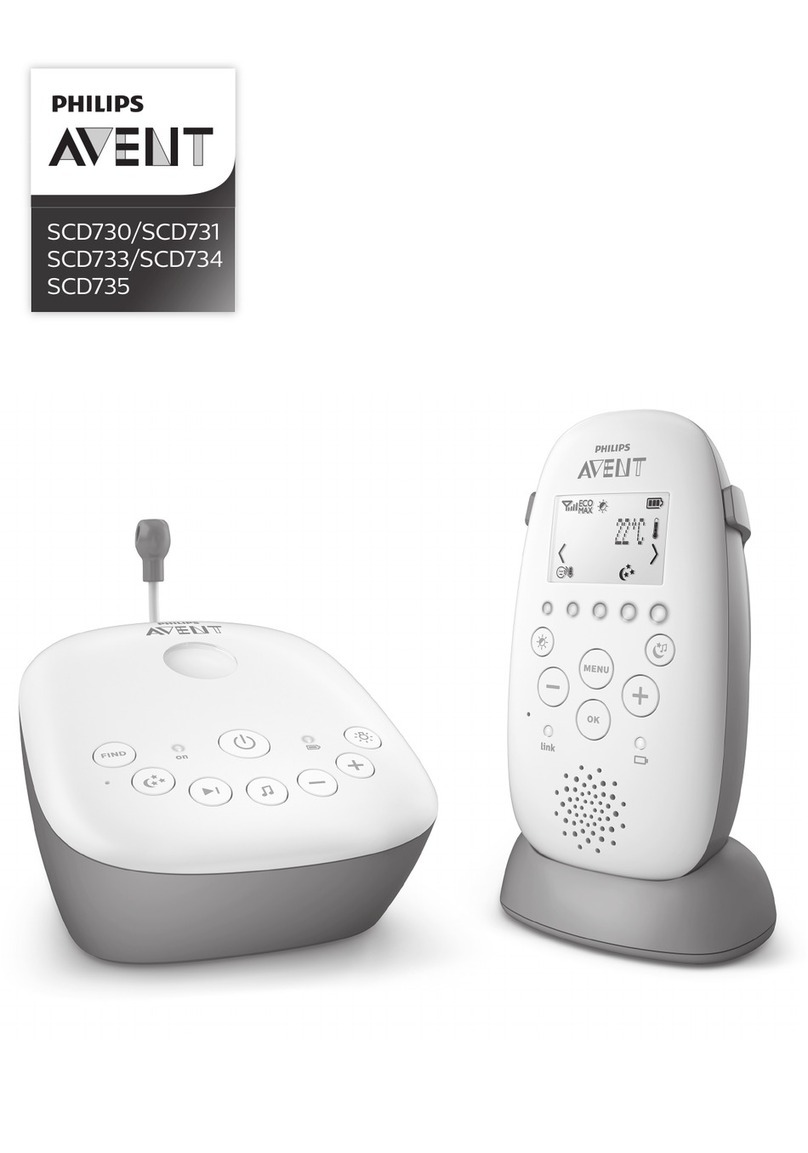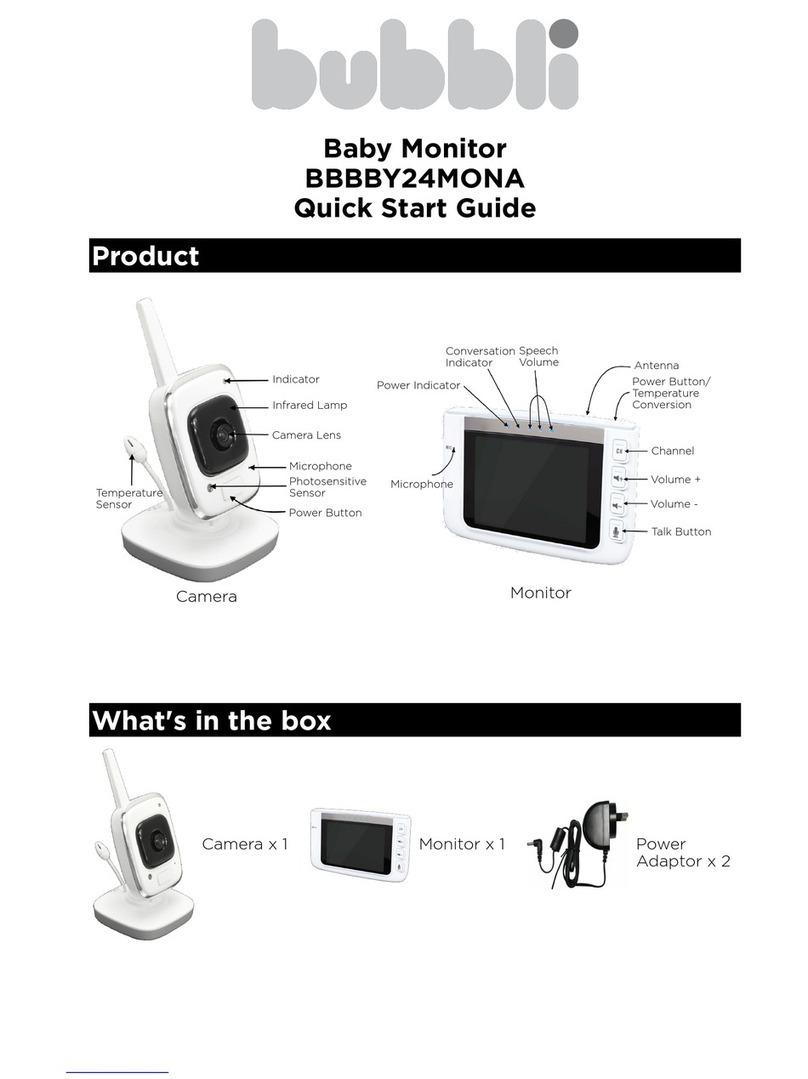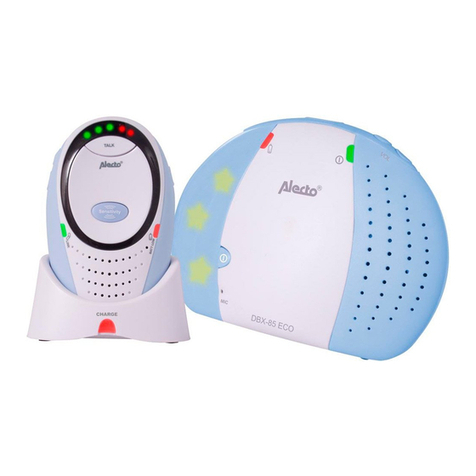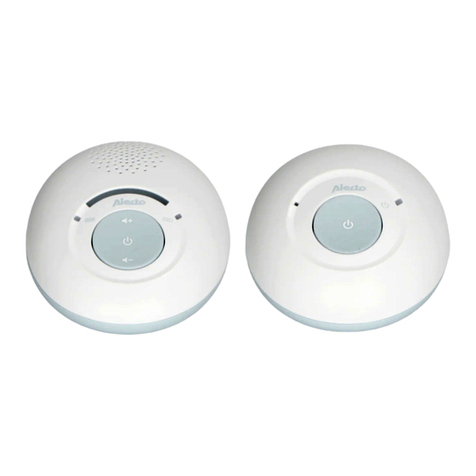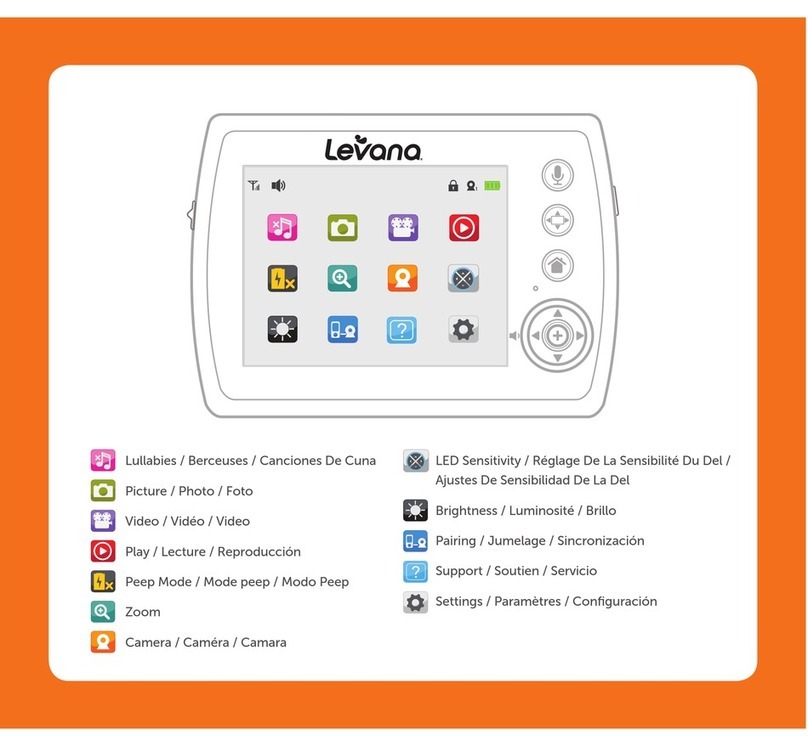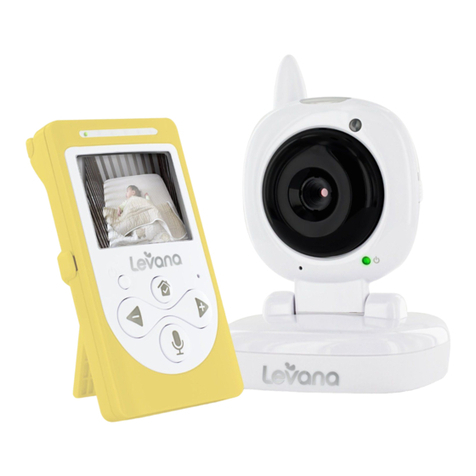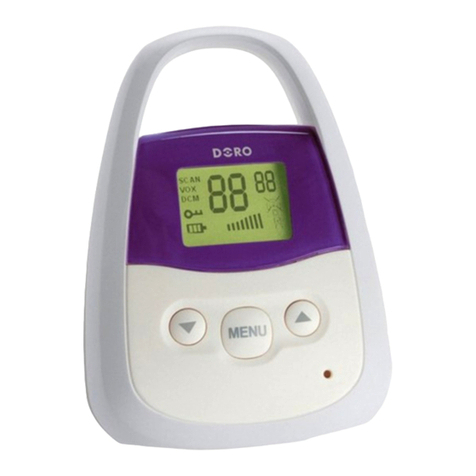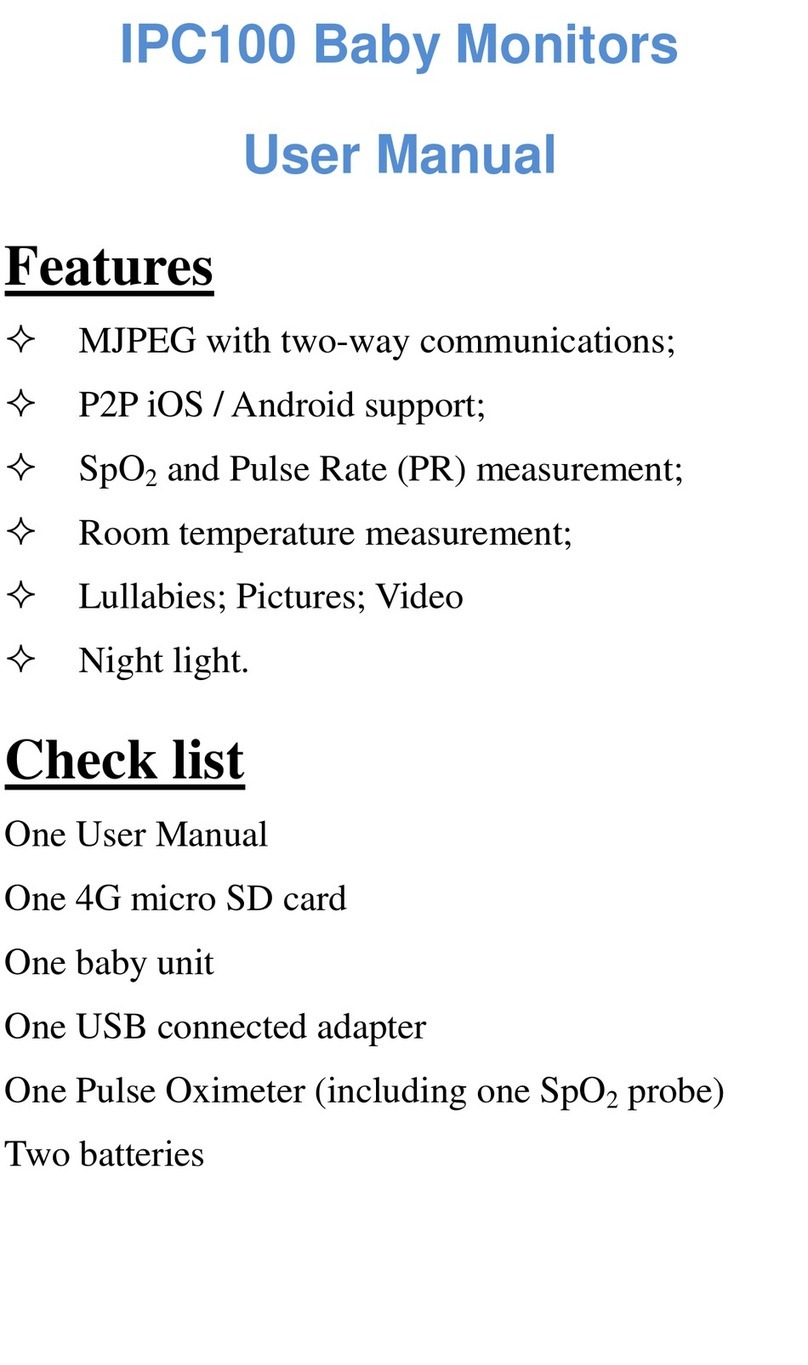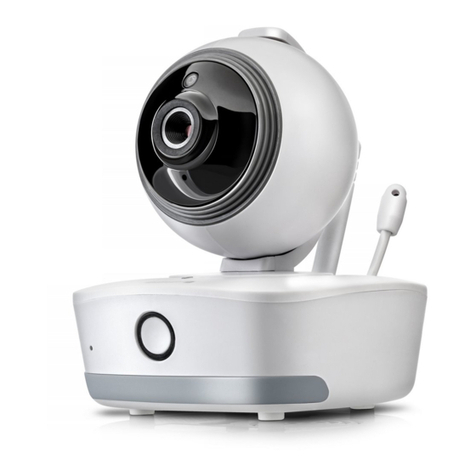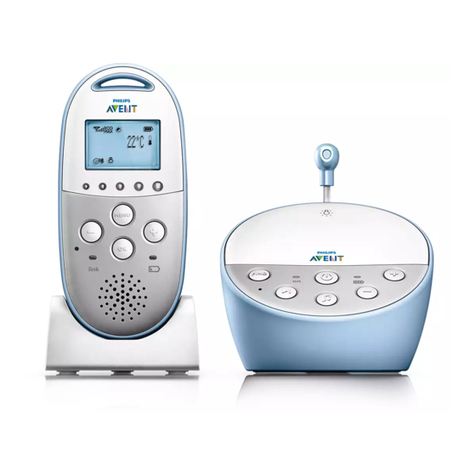Transistor Lynx Baby Alarm User manual

Baby Alarm
Manual
Ordering number: 200 30 34

2
ENGLISH: Baby Alarm for our Lynx alert system ...............................page 3
DEUTSCH: Babyalarm für das Lynx Alarmsystem..............................Seite 8
FRANÇAIS: Écoute-bébé conçu pour le système d’alerte Lynx ........page 13
ITALIANO: Baby Control per il nostro sistema di allarme Lynx..........Pag. 18
NEDERLANDS: Babyalarm voor het Lynx-systeem............................Pag. 23
NORSK: Barnevakt til varslingssystemet Lynx
..................................... side 28
SVENSKA: Barnvakt till varseblivningssystemet Lynx
............................. sid 33

3
ENGLISH: Baby Alarm for our Lynx alert system ...............................page 3
DEUTSCH: Babyalarm für das Lynx Alarmsystem..............................Seite 8
FRANÇAIS: Écoute-bébé conçu pour le système d’alerte Lynx ........page 13
ITALIANO: Baby Control per il nostro sistema di allarme Lynx..........Pag. 18
NEDERLANDS: Babyalarm voor het Lynx-systeem............................Pag. 23
NORSK: Barnevakt til varslingssystemet Lynx
..................................... side 28
SVENSKA: Barnvakt till varseblivningssystemet Lynx
............................. sid 33
ENGLISH
Baby Alarm for the Lynx system
The Baby Alarm forms part of Lynx – our wireless alert system for people with
impaired hearing. Lynx uses various transmitters and receivers that alert the user to
noises such as a ringing telephone or doorbell, or the first signs of a fire.
The Baby Alarm reacts to the child crying and has a built-in transmitter that sends
signals wirelessly to the receiver. One or more repeaters may also be installed in order
to amplify the alarm signal and thus extend its range.
Overview
On/Off button.
LED (shows red
when sound source
is activated).
Microphone.
Knob for adjusting
sound sensitivity.
Cover (over battery
and microswitches).
Example of how the
signal is transmitted:
Lynx Baby Alarm
(transmitter)
Lynx Repeater
(amplifier) Lynx Tactum
(receiver)
Aerial.

4
ENGLISH
Switching the Baby Alarm on and off
Switching on: Press On/Off button briefly. The red LED flashes.
Switching off: Hold down On/Off button for four seconds until the red LED goes
off. NOTE: to save the battery, switch off Baby Alarm when not in use.
Adjusting sound sensitivity
To make the alarm more sensitive to the baby’s cries, increase sound sensitivity by
turning the knob on the front face clockwise. If the alarm reacts to noises other
than the baby’s cries, reduce sensitivity by turning the knob anti-clockwise.
When the child cries
When the child’s cries exceed the set sound level, a wireless signal is sent to the recei-
ver installed in the Lynx system. At the same time, the red lamp on the Baby Alarm
lights up for a few seconds.
The alert is given by vibration and symbols, loud noise or flashing light, depending
on the type of receiver.
Read the user manual for the receiver installed!
Battery warning
The Baby Alarm is powered by a battery. Normal service life for an alkaline battery
is about 3 months, and for a lithium battery about 6 months. When battery power
begins to fail, the Baby Alarm will send out an alert. It sends a flat-battery warning
along with the alarm to the receiver in the alerting system.
Read the user manual for the receiver installed!
Installing the Baby Alarm
1. Open the blue cover and fit the
battery supplied.
2. Fit the Baby Alarm in the vicinity
of the child’s cot, out of reach of
the child.

5
8-pole microswitch
Alarm selector switch
Channel selector switch
ENGLISH
Pause
When the pause function is on, the Baby Alarm works as follows: When a “child crying” alarm has been
sent out, there is then a four minute pause before another alarm is sent out. This provides an opportu-
nity to attend to the child before another alarm is activated.
Switching on pause: Set microswitch 3 to Off (see below). The red LED flashes every four seconds to
show that the Baby Alarm is set at pause.
When the Baby Alarm is set at pause, the pause period can be changed if desired. The pause period can
be set to 4 (pre-set), 15 or 30 minutes. Press the On/Off button the required number of times as
indicated below.
The Baby Alarm is equipped with a transmitter that sends signals wirelessly to the receiver installed in
the Lynx system. The transmitter is located under the blue cover and has an 8-pole microswitch that is
used for two purposes:
• Alarm symbol (fire, telephone, door, etc). The alarm symbol on the Baby Alarm is pre-set to Baby
Alarm. NOTE: If Lynx MiniVib is used as a receiver, the alarm symbol on the Baby Alarm
must be changed, see next page.
• Channels. There is a total of 16 different channels (0-9, A-F). Transmitters and receivers in the
system must be set to the same channel so that they can communicate. Channel 0 is reserved for a
common fire alarm and should not be used. The Baby Alarm and all receivers in the Lynx system are
all pre-set to channel 9, and then act together without alteration.
Changing the alarm symbol and the channel setting
30
154
1 press,
flashes twice
1 press,
flashes once
1 press, flashes
three times
Switching off pause: Set microswitch 3 to ON (see below). Flashing stops after 4, 15 or 30 minutes,
depending on pause setting when last switched off.
On (pre-set)=No pause function, Off=Pause function activated
Pause switch On/Off

6
ENGLISH
Setting the microswitches
for channel selection: 1 2 3 4 5
0Off Off On Off Off
1On Off On Off Off
2Off On On Off Off
3On On On Off Off
4Off Off On On Off
5On Off On On Off
6Off On On On Off
7On On On On Off
8Off Off On Off On
9On Off On Off On
AOff On On Off On
BOn On On Off On
COff Off On On On
DOn Off On On On
EOff On On On On
FOn On On On On
Switch:
Channel: Common channel
for fire alarm
Pre-set channel
on Baby Alarm
and all receivers
Changing the channel setting
In some cases, it may be necessary to change the channel setting. If two or more users live near one
another, the alarms can interfere. This can be rectified by changing the channel settings so that they are
different for everyone. Any channel can be selected except Channel 0.
If you wish to change channel, set the switches for the Baby Alarm in accordance with the table below.
To change channels on the receiver, see user manual.
Setting the microswitches
for symbol selection:
Changing the alarm symbol when using MiniVib
Set the switches on the Baby Alarm as shown in the table below. The Alarm Call/Pager alarm symbol is set
as an Alarm Call on MiniVib.
Alarm symbol for use
with MiniVib
Pre-set alarm symbol
6 7 8
Telephone On On Off
Door On Off On
Fire Off On On
Baby Off Off Off
Alarm call/
Pager On Off Off
Optional Off Off On
Public alert Off On Off
Switch:
Alarm
Symbol:

7
ENGLISH
Troubleshooting
Type of fault Action
Baby Alarm does not detect sound. 1. Check that the battery is OK. 2. Check that
the Baby Alarm is switched on. 3. Check the
sensitivity setting. 4. Switch off pause, if applica-
ble (see page 5).
Baby Alarm gives a false alarm. 1. Check sensitivity setting (reduce if necessary).
2. If the receiver is a MiniVib, check that the
alarm symbol on the Baby Alarm is set to Alarm
Call/Pager (see page 6).
Cleaning and maintenance
Vacuum outside of Baby Alarm with a soft brush several times per year. Use a lightly moistened cloth to
dry off the exterior. Never use cleaning products or solvents.
Repairs
If the product malfunctions it must be sent to an authorised technician for repair. Do not attempt to
open the case of the device since this would invalidate the warranty. If your product requires service,
please contact your hearing care professional for assistance.
Waste disposal
This product contains electrical or electronic equipment and should be disposed of carefully
in the interest of your safety and the environment. Please contact your local hearing care
professional concerning disposal of the product.
General Precautions
• Low-energy radiation (eg from burglary alarms, room surveillance systems, radio equipment,
mobile telephones) will not damage the device. They could, however, momentarily affect the
sound quality or create noise in the device.
• Warning: External devices connected to the product must be safe according the requirements
of EN 60601-1-1, EN 60335-1 or EN 60065, as appropriate.
Technical data
Frequency: 433.92 MHz.
Modulation: AM.
Battery: 1 x 9 V type 6LR61 or IEC 6F22.
Power consumption: Standby: approx. 0.2 mA. Transmitting: approx. 16 mA.
Aerial: Integrated (170 mm), partially concealed in cover.
Range: Up to 30 m indoors.
Channels: 16.
Function code: 4 bit (3 bit selectable via microswitches).
Transmitter power: <10 mW radiation.
Dimensions: 170 x 70 x 45 mm.
Weight: approx. 200 g.
Any issues relating to the EU Medical Device Directive
93/42/EEC should be directed to AB Transistor Sweden.

8
DEUTSCH
Babyalarm für das Lynx System
Der Babyalarm ist Teil des Lynx Systems, unseres drahtlosen Alarmsystems für hörge-
schädigte Personen. Das Lynx-System informiert den Benutzer mit Hilfe verschiede-
ner Sender und Empfänger über Geräusche, wie das Klingeln des Telefons oder der
Türklingel und alarmiert ihn bei Gefahren, beispielsweise bei einem Brand.
Der Babyalarm reagiert auf das Schreien eines Babys und sendet über den eingebau-
ten Sender Funksignale an den Empfänger. Durch die Installation von Verstärkern
kann die Reichweite des Alarmsignals erhöht werden.
Übersicht
Ein/Aus Taste
LED (leuchtet rot,
wenn Geräusche
erkannt werden).
Mikrofon
Knopf zum Einstellen der
Geräuschempfindlichkeit.
Abdeckung (für
Batteriefach und
Mikroschalter).
Beispiel für die Signalübertragung: Lynx Baby Alarm
(Sender)
Lynx Repeater
(Verstärker) Lynx Tactum
(Empfänger)
Antenn.

9
DEUTSCH
Babyalarm ein- und ausschalten
Einschalten: Drücken Sie kurz die Ein/Aus Taste. Die rote LED leuchtet auf.
Ausschalten: Drücken Sie die Ein/Aus Taste vier Sekunden lang, bis die rote LED
erlischt. HINWEIS: Schalten Sie den Babyalarm aus, wenn er nicht gebraucht wird,
um Batterien zu sparen.
Geräuschempfindlichkeit einstellen
Drehen Sie den Knopf auf der Vorderseite des Babyalarms nach rechts, um die
Empfindlichkeit des Alarms zu erhöhen, so dass auch leisere Geräusche des Babys
gesendet werden. Wenn der Alarm auch auf andere Geräusche reagiert, senken Sie die
Empfindlichkeit, indem Sie den Knopf nach links drehen.
Wenn das Kind schreit
Wenn das Schreien des Kindes den eingestellten Geräuschpegel überschreitet, wird
ein Funksignal an den im Lynx System installierten Empfänger gesendet. Gleichzeitig
leuchtet die rote LED am Babyalarm für einige Sekunden auf.
Das Warnsignal kann je nach Empfängertyp Vibration und Symbole, laute Geräusche
oder Blitzlicht erzeugen.
Einzelheiten hierzu finden Sie in der Bedienungsanleitung des Empfängers.
Niedrige Batterieleistung
Der Babyalarm wird über eine Batterie mit Strom versorgt. Die normale
Lebensdauer einer Alkali-Batterie beträgt etwa 3 Monate, die einer Lithium-Batterie
etwa 6 Monate. Wenn die Leistung der Batterie nachlässt, sendet der Babyalarm ein
Warnsignal. Das Warnsignal für niedrige Batterieleistung wird zusammen mit dem
Alarmsignal an den Empfänger im Alarmsystem gesendet.
Einzelheiten hierzu finden Sie in der Bedienungsanleitung des Empfängers.
Babyalarm installieren
1. Öffnen Sie die blaue Abdeckung und
legen Sie die mitgelieferte Batterie ein.
2. Stellen Sie den Babyalarm in der
Nähe des Kinderbettes außerhalb der
Reichweite des Kindes auf.

10
DEUTSCH
Pause
Die Funktion Pause am Babyalarm bewirkt folgendes: Nachdem ein “Baby-schreit”-Alarm gesendet
wurde, dauert es vier Minuten, bis der nächste Alarm gesendet wird. So haben Sie die Möglichkeit,
sich um Ihr Baby zu kümmern, bevor ein weiterer Alarm erzeugt wird.
Pause einschalten: Stellen Sie den Mikroschalter 3 auf Off (siehe unten). Die rote LED blinkt alle vier
Sekunden auf, und zeigt so an, dass die Funktion Pause aktiviert ist.
Wenn der Babyalarm auf Pause gestellt ist, können Sie die Pausenzeiten verändern. Die Pausenzeiten
können auf 4 (voreingestellt), 15 oder 30 Minuten eingestellt werden. Drücken Sie die Ein/Aus Taste
wie unten aufgeführt, um die Zeiten einzustellen.
Alarmsymbole und Kanalwahl ändern
30
154
1 Mal drücken,
blinkt 2 Mal
1 Mal drücken,
blinkt 1 Mal
1 Mal drücken,
blinkt 3 Mal
Pause ausschalten: Stellen Sie den Mikroschalter 3 auf ON (siehe unten). Nach 4, 15 oder 30
Minuten, je nach zuletzt eingestellter Pausenzeit, hört der Babyalarm auf zu Blinken.
Alarmschalter
Kanalwahl-Schalter
8-poliger Mikroschalter Pausenschalter ein/aus
On=Funktion Pause deaktiviert, Off = Funktion Pause aktiviert
Der Babyalarm ist mit einem Sender ausgestattet, der Signale per Funk an den im Lynx-System
installierten Empfänger sendet. Der Sender befindet sich unter der blauen Abdeckung und hat einen
8poligen Mikroschalter, der zwei Funktionen hat:
• Alarmsymbol (Feuer, Telefon, Tür, usw.). Der Babyalarm ist auf ‚Babyalarm’ voreingestellt, was
nicht geändert werden darf. HINWEIS: Wenn der Lynx MiniVib als Empfänger verwendet wird,
muss das Alarmsymbol am Babyalarm geändert werden, siehe nächste Seite.
• Kanäle. 16 verschiedene Kanäle können eingestellt werden (0-9, A-F). Damit Sender und
Empfänger eines Systems miteinander kommunizieren können, müssen sie auf den gleichen Kanal
eingestellt sein. Kanal 0 ist für einen allgemeinen Feueralarm reserviert und darf nicht verwendet
werden. Der Babyalarm und alle Empfänger des Lynx Systems sind auf Kanal 9 voreingestellt und
können ohne Änderung der Einstellung miteinander kombiniert werden.

11
DEUTSCH
6 7 8
Telefon On On Off
Tür On Off On
Feuer Off On On
Baby Off Off Off
Weckruf/
Mobilfunkempfänger On Off Off
Optional Off Off On
Öffentlicher Alarm Off On Off
Schalterposition für
die Kanalwahl: 1 2 3 4 5
0Off Off On Off Off
1On Off On Off Off
2Off On On Off Off
3On On On Off Off
4Off Off On On Off
5On Off On On Off
6Off On On On Off
7On On On On Off
8Off Off On Off On
9On Off On Off On
AOff On On Off On
BOn On On Off On
COff Off On On On
DOn Off On On On
EOff On On On On
FOn On On On On
Schalter:
Kanal: Allgemeiner Kanal
für Feueralarm
Voreingestellter Kanal
für Babyalarm und
alle Empfänger
Kanalwahl ändern
In einigen Fällen kann es sein, dass ein anderer Kanal gewählt werden muss. Beispielsweise wenn eine
oder mehrere Personen in der Nachbarschaft die gleichen Geräte verwenden, können die Alarme in-
terferieren. Das kann durch Ändern der Kanaleinstellungen ausgeglichen werden, so dass jeder einen
eigenen Kanal benutzt. Jeder Kanal kann gewählt werden, außer Kanal 0.
Wenn Sie den Kanal ändern möchten, stellen Sie die Schalter am Babyalarm entsprechend der u. a.
Tabelle ein. Bitte sehen Sie in der Anleitung des jeweiligen Empfängers nach, wie die Kanäle
geändert werden.
Schalterposition für
die Kanalwahl:
Alarmsymbol ändern bei Verwendung des MiniVib
Stellen Sie die Schalter am Babyalarm so ein, wie in der folgenden Tabelle dargestellt. Das Alarmsymbol
Weckruf / Mobilfunkempfänger ist als Weckruf auf dem MiniVib eingestellt.
Alarmsymbol bei
Verwendung des
MiniVib
Voreingestelltes
Alarmsymbol
Alarmsymbol:
Schalter:

12
DEUTSCH
Fehlerbehebung
Fehler Maßnahme
Babyalarm reagiert nicht auf
Geräusche.
1. Überprüfen Sie, ob die Batterie in Ordnung ist. 2. Überprüfen Sie, ob der Baby-
alarm eingeschaltet ist. 3. Prüfen Sie die Einstellung der Geräuschempfindlichkeit.
4. Schalten Sie gegebenenfalls die Pausefunktion ab (siehe Seite 10).
Babyalarm sendet falschen
Alarm.
Prüfen Sie die Einstellung der Empfindlichkeit (wenn nötig herunterdrehen).
Der Empfänger reagiert
nicht.
1. Überprüfen Sie die Reichweite. Verkürzen Sie nach Möglichkeit den Abstand
zwischen Babyalarm und Empfänger, oder erhöhen Sie die Reichweite mit Hilfe eines
Verstärkers. 2. Wird ein MiniVib als Empfänger verwendet, prüfen Sie, ob das Alarm-
symbol am Babyalarm auf Weckruf/Mobilfunkempfänger eingestellt ist (siehe Seite 11).
Reinigung und Wartung
Entfernen Sie mehrmals jährlich den Staub am Babyalarm mit einer weichen Bürste.
Verwenden Sie ein leicht feuchtes Tuch, um das Gehäuse zu reinigen. Verwenden Sie niemals
Reinigungs- oder Lösungsmittel.
Service
Ist das Produkt defekt, muss es an einen autorisierten Fachmann zur Reparatur gegeben werden. Öffnen Sie das
Produkt niemals selbst, sonst erlischt die Garantie. Bei Problemen mit dem Produkt wenden Sie sich bitte an
Ihr Zentrum für Hörhilfe oder Ihren Händler.
Entsorgung
Dieses Produkt enthält elektrische oder elektronische Teile. Entsorgen Sie das Produkt
nicht im Hausmüll. Fragen Sie bitte Ihr Zentrum für Hörhilfe oder Ihren Händler nach
Entsorgungsmöglichkeiten.
Allgemeine Vorsichtsmaßnahmen
• Niedrigenergie-Strahlung (z. B. von Alarmanlagen, Überwachungssystemen, Funkanlagen oder
Mobiltelefonen) beeinträchtigen das Produkt nicht. Trotzdem kann diese Art Strahlung in manchen
Fällen Störgeräusche im Produkt verursachen.
• Achtung: An das Produkt angeschlossene externe Geräte müssen die Sicherheitsanforderungen der
europäischen Norm EN 60601-1-1, EN 60335-1 bzw. EN 60065 erfüllen.
Technische Daten
Frequenz: 433,92 MHz.
Modulation: AM.
Batterie: 1 x 9 V Typ 6LR61 oder IEC 6F22.
Stromverbrauch: Standby-Modus: ca. 0,2 mA. Übertragungsmodus: ca. 16 mA.
Antenne: Integriert (170 mm), teilweise im Gehäuse.
Reichweite: bis zu 30 m in Gebäuden.
Kanäle: 16.
Funktionscode: 4 Bit (3 Bit wählbar über Mikroschalter).
Senderleistung: <10 mW Strahlung.
Abmessungen: 170 x 70 x 45 mm.
Gewicht: ca. 200 g.
Hersteller im Sinne der EG-Richtlinie
93/42 EWG: AB Transistor Sweden.

13
FRANÇAIS
Écoute-bébé conçu pour le système d’alerte Lynx
L’écoute-bébé fait partie intégrante de Lynx, notre système d’alerte sans fil destiné
aux malentendants. Ce système utilise divers émetteurs et récepteurs qui avertissent
l’utilisateur des sons qui accompagnent notre vie quotidienne tels que sonnerie du
téléphone et sonnette de la porte d’entrée, ou des premiers signes d’un incendie.
L’écoute-bébé réagit aux cris du bébé et est doté d’un émetteur intégré qui envoie un
signal radio au récepteur. Le cas échéant, il est possible d’installer un ou plusieurs
amplificateurs supplémentaires qui amplifient le signal afin d’accroître sa portée.
Présentation générale
Bouton de
marche/arrêt
(On/Off). Voyant (rouge
lorsque la source
sonore est activée).
Microphone.
Molette de réglage de la
sensibilité acoustique.
Couvercle
(abrite la pile et
le microrupteur).
Exemple de transmission du signal : Lynx Baby Alarm (écoute-bébé )
(émetteur)
Lynx Tactum
(récepteur)
Antenne.
Lynx Repeater
(amplificateur)

14
FRANÇAIS
Activation et désactivation de l’écoute-bébé
Activation : appuyez brièvement sur le bouton de marche/arrêt (on/off).
Le voyant rouge clignote.
Désactivation : maintenez le bouton on/off enfoncé pendant quatre secondes jusqu’à
ce que le voyant rouge s’éteigne. REMARQUE : pour préserver la durée de vie de la
pile, désactivez l’écoute-bébé en cas d’inutilisation prolongée.
Réglage de la sensibilité acoustique
Pour accroître la sensibilité de l’appareil aux cris du bébé, tournez la molette de la
face avant dans le sens des aiguilles d’une montre. Si l’écoute-bébé réagit à des bruits
autres que les cris du bébé, réduisez la sensibilité acoustique en tournant la molette
dans le sens inverse des aiguilles d’une montre.
En cas de pleurs du bébé
Lorsque les pleurs du bébé dépassent le niveau sonore défini, un signal radio est en-
voyé au récepteur du système Lynx. Simultanément, le voyant rouge de l’écoute-bébé
s’allume pendant quelques secondes.
L’avertissement est signalé par des vibrations et des symboles, un bruit fort ou un
voyant clignotant, selon le type de récepteur.
Lisez le mode d’emploi du récepteur correspondant !
Avertissement lié à la pile
L’écoute-bébé est alimenté par une pile. La durée de vie standard d’une pile alcaline
est d’environ 3 mois et de 6 mois pour une pile au lithium. Lorsque l’alimentation
par pile commence à faiblir, l’écoute-bébé émet une alerte en transmettant un
avertissement de pile faible avec une alarme au récepteur du système.
Lisez le mode d’emploi du récepteur correspondant !
Installation de l’écoute-bébé
1. Ouvrez le couvercle bleu et installez
la pile fournie.
2. Posez l’écoute-bébé à proximité
du berceau, mais hors de portée
de l’enfant.

15
FRANÇAIS
Pause
Lorsque le mode pause est activé, l’écoute-bébé fonctionne comme suit : Lorsqu’une alerte « bébé pleure » est
émise, il y a une pause de 4 minutes avant qu’une autre alerte ne soit émise. Vous pouvez ainsi vous occuper
de l’enfant avant le déclenchement d’une autre alarme.
Activation de la pause : Réglez le microrupteur 3 sur la position Off (voir ci-dessous). Le voyant rouge
clignote toutes les quatre secondes pour indiquer que l’écoute-bébé est en mode pause.
Lorsque l’écoute-bébé est en mode pause, vous pouvez modifier la période de pause si vous le souhaitez. La
pause peut être réglée sur 4 (préréglage), 15 ou 30 minutes. Appuyez sur le bouton on/off autant de fois que
nécessaire, tel qu’indiqué ci-dessous.
Modification du symbole sonore et du réglage du canal
30
154
Une pression,
deux clignotements
Une pression,
un clignotement
Une pression,
trois clignotements
Désactivation de la pause : Réglez le microrupteur 3 sur la position On (voir ci-dessous). Le clignote-
ment s’arrête après 4, 15 ou 30 minutes en fonction du réglage défini lors de la dernière désactivation.
On (préréglage) = pas de fonction Pause, Off = fonction Pause activée
Interrupteur de sélection d’alarme
Interrupteur de sélection de canal
Microrupteur à 8 broches Interrupteur Pause on/off
L’écoute-bébé est équipé d’un émetteur qui transmet des signaux radio au récepteur placé dans le
système Lynx. L’émetteur situé sous le couvercle bleu est doté d’un microrupteur à 8 pôles qui offre
deux options :
• Symbole d’alarme (incendie, téléphone, sonnette, etc.). L’écoute-bébé est préréglé sur « Écoute-bébé ».
REMARQUE : Si le Lynx MiniVib est utilisé comme récepteur, il faut changer le symbole
sonore de l’écoute-bébé, voir à la page suivante.
• Canaux. Seize canaux sont à votre disposition (0-9, A-F). Les émetteurs et les récepteurs du
système doivent être réglés sur le même canal pour pouvoir communiquer. Le canal 0 est réservé
à une alarme incendie courante et ne doit pas être utilisé. L’écoute-bébé et tous les récepteurs du
système Lynx sont préréglés sur le canal 9 ; ils agissent ensuite ensemble sans conflit.

16
FRANÇAIS
6 7 8
Téléphone On On Off
Sonnette Porte On Off On
Incendie Off On On
Bébé Off Off Off
Signal d’alarme /
Bipeur On Off Off
Optionnel Off Off On
Alerte au public Off On Off
Interrupteur :
1 2 3 4 5
0Off Off On Off Off
1On Off On Off Off
2Off On On Off Off
3On On On Off Off
4Off Off On On Off
5On Off On On Off
6Off On On On Off
7On On On On Off
8Off Off On Off On
9On Off On Off On
AOff On On Off On
BOn On On Off On
COff Off On On On
DOn Off On On On
EOff On On On On
FOn On On On On
Interrupteur :
Canal : Canal commun
pour alarme
incendie
Canal préréglé sur
l’écoute-bébé et
l’ensemble des
récepteurs
Modification du réglage du canal
Il est parfois nécessaire de modifier le réglage du canal. Si deux utilisateurs minimum vivent à proxim-
ité, les alarmes peuvent interférer. Il est possible de corriger cette situation en changeant les réglages des
canaux. Ils doivent alors être différents pour chaque personne. Vous pouvez choisir n’importe quel canal
sauf le canal 0.
Si vous souhaitez changer de canal, réglez les interrupteurs pour l’écoute-bébé en respectant le tableau
ci-dessous. Pour modifier les canaux du récepteur, consultez le manuel d’utilisation.
Réglages des microrupteurs
de sélection d’alarme :
Changement du symbole sonore en cas d’utilisation du MiniVib
Réglez les interrupteurs de l’écoute-bébé comme indiqué dans le tableau ci-dessous. Le symbole sonore du
Signal d’alarme/Bipeur est réglé comme Signal d’alarme sur le MiniVib.
Symbole sonore
à utiliser avec le
MiniVib
Symbole sonore
pré-réglé
Réglages des microrupteurs
de sélection de canal :
Symbole
Sonore :

17
FRANÇAIS
Diagnostic d’anomalies
Type d’anomalie Action
L’écoute-bébé ne détecte aucun son. 1. Vérifiez l’état de la pile. 2. Vérifiez que l’écoute-bébé est bien allumé.
3. Vérifiez le réglage de la sensibilité. 4. Désactivez la fonction pause, si
nécessaire (voir page 15).
L’écoute-bébé émet une fausse alerte. Contrôlez le réglage de la sensibilité (diminuez la sensibilité le cas échéant).
Le récepteur ne réagit pas. Vérifiez
la portée .
1. Essayez de réduire la distance entre l’écoute-bébé et le récepteur ou
installez un amplificateur pour augmenter la portée. 2. Si le récepteur est
un MiniVib, vérifiez que le symbole sonore de l’écoute-bébé est réglé sur
Signal d’alarme/Bipeur (voir page 16).
Nettoyage et entretien
Aspirez l’extérieur de l’écoute-bébé avec une brosse douce plusieurs fois par an. Utilisez un chiffon
légèrement humide pour essuyer l’extérieur. N’utilisez jamais de produits de nettoyage ou de solvants.
Réparation
Si le produit est endommagé, il doit être transmis à un technicien agréé pour réparation. N’ouvrez
jamais le produit vous-même sous peine d’annuler la garantie. Contactez votre centre d’aide auditive ou
le vendeur si vous rencontrez des problèmes avec le produit.
Élimination
Ce produit comporte du matériel électrique ou électronique. Ne le mettez pas à la poubelle
en fin de vie. Contactez votre centre d’aide auditive ou le vendeur pour obtenir des conseils
sur la méthode d’élimination la plus sûre du produit.
Précautions générales
• La radiation de faible énergie (des alarmes anti-vol, des systèmes de surveillance, des équipements radio
et des téléphones portables, par exemple) ne présente aucun risque pour le produit. Cependant, dans
certains cas, ce type de radiation peut générer un bruit induit dans le produit.
• Avertissement : Les dispositifs externes connectés au produit ne doivent présenter aucun danger confor-
mément aux exigences des normes EN 60601-1-1, EN 60335-1 ou EN 60065, suivant le cas.
Caractéristiques techniques
Fréquence : 433.92 MHz.
Modulation : AM.
Pile : 1 x 9 V, type 6LR61 ou IEC 6F22.
Consommation électrique : Veille : env. 0,2 mA. Émission : env. 16 mA.
Antenne : Intégrée (170 mm), partiellement dissimulée dans le couvercle.
Portée : jusqu’à 30 m en intérieur.
Canaux : 16.
Code fonctionnel : 4 bits (sélection possible de 3 bits via des microrupteurs).
Puissance d’émission : radiation < 10 mW.
Dimensions : 170 x 70 x 45 mm.
Poids : environ 200 g.
Pour toute question relative à la Directive CE 93/42 sur les
dispositifs médicaux, veuillez contacter AB Transistor Sweden.

18
ITALIANO
Baby Control per il nostro sistema di allarme Lynx
Il baby control costituisce parte integrante di Lynx – il nostro sistema di allarme wire-
less per persone con disturbi all’udito. Lynx utilizza vari trasmettitori e ricevitori che
avvisano l’utente su rumori come un telefono che squilla o un campanello che suona
oppure sui primi segni di un incendio.
Il baby control reagisce al pianto del bambino e possiede un trasmettitore incorporato
che invia i segnali al ricevitore tramite tecnologia senza fili. È anche possibile installare
uno o più amplificatori per amplificare il segnale di allarme e aumentarne la portata.
Esempio su come viene
Panoramica
Pulsante On/off.
LED (si accende di rosso
quando viene attivata la
sorgente sonora).
Microfono.
Manopola per regolare
la sensibilità sonora.
Coperchio (sopra
la batteria e i
microinterruttori).
trasmesso il segnale: Lynx Baby Alarm (baby control)
(trasmettitore)
Lynx Repeater
(amplificatore)
Lynx Tactum
(ricevitore)
Antenna parabolica.

19
ITALIANOITALIANO
Inserimento e disinserimento del baby control
Inserimento: Prema brevemente il pulsante On/Off. Il LED rosso lampeggia.
Disinserimento: Tenga premuto il pulsante On/Off per quattro secondi fino a che il
LED rosso si spegne. NOTA: per salvaguardare la batteria, disinserire il baby control
quando non è utilizzato.
Regolazione della sensibilità sonora
Per far sì che l’allarme sia più sensibile al pianto del bambino, aumenti la sensibilità
sonora ruotando la manopola sul frontale in senso orario. Se l’allarme reagisce a
rumori diversi dal pianto del bambino, riduca la sensibilità ruotando la manopola in
senso antiorario.
Quando il bambino piange
Quando il pianto del bambino supera il livello sonoro impostato, viene inviato un
segnale wireless al ricevitore installato nel sistema Lynx. Contemporaneamente la spia
rossa sul baby control si accende per alcuni secondi.
L’avvertimento viene dato tramite vibrazione e simboli visivi, avvisi acustici forti o
luce lampeggiante, in funzione del tipo di ricevitore.
Leggere il manuale dell’utente per il ricevitore installato!
Allarme batteria
Il baby control viene alimentato da una batteria. La durata in servizio normale di
una batteria alcalina è di circa 3 mesi, mentre quella di una batteria al litio è di circa
6 mesi. Quando l’alimentazione a batteria inizia a mancare, il baby control invia
un avvertimento. L’avvertimento batteria scarica viene inviato insieme all’allarme al
ricevitore nel sistema di allarme.
Leggere il manuale dell’utente per il ricevitore installato!
Installazione del baby control
1. Apra il coperchio blu e installi la
batteria fornita in dotazione.
2. Installi il baby control nelle vicinanze
della culla del bambino, ma al di
fuori della sua portata.

20
ITALIANO
Pausa
Quando la funzione di pausa è attiva, il baby control funziona nel modo seguente: Quando è stato
emesso un allarme “bambino piange”, segue una pausa di quattro minuti prima che venga emesso un
altro allarme. Questo fornisce l’opportunità di prendersi cura del bambino prima che venga lanciato un
altro allarme.
Inserimento della pausa: Impostare il microinterruttore 3 su Off (vedasi sotto). Il LED rosso
lampeggia ogni quattro secondi per indicare che il baby control è impostato su pausa.
Quando il baby control è impostato su pausa, il periodo di pausa può essere modificato a piacere. Il
periodo di pausa può essere impostato su 4 (valore preimpostato), 15 o 30 minuti. Prema il pulsante
On/Off il numero di volte indicato in basso.
Il baby control è dotato di un trasmettitore che invia segnali al ricevitore installato nel sistema Lynx
tramite tecnologia senza fili. Il trasmettitore è situato sotto il coperchio blu e dispone di un microinter-
ruttore a 8 poli che viene utilizzato per due scopi:
• Simbolo di allarme (antincendio, telefono, porta, ecc.). Il baby control è preimpostato su “allarme
neonato”. NOTA: Se il Lynx MiniVib viene usato come ricevitore, il simbolo di allarme sul
Baby Control deve essere cambiato, vedasi la pagina seguente.
• Canali. Complessivamente sono disponibili 16 canali diversi (0-9, A-F). I trasmettitori e i ricevitori
presenti nel sistema devono essere impostati sullo stesso canale in modo da poter comunicare. Il
Canale 0 è riservato per un allarme antincendio comune e non dovrebbe essere utilizzato. Il baby
control e tutti i ricevitori nel sistema Lynx sono preimpostati sul canale 9 e in seguito agiscono
insieme senza modifiche.
Cambio del simbolo di allarme e dell’impostazione del canale
30
154
1 pressione,
lampeggia due volte
1 pressione,
lampeggia una volta
1 pressione,
lampeggia tre volte
Disinserimento della pausa: Impostare il microinterruttore 3 su ON (vedasi sotto). Il lampeggiamento
si interrompe dopo 4, 15 o 30 minuti in funzione dell’impostazione della pausa in occasione dell’ultimo
disinserimento.
Selettore di allarme
Selettore di canale
On (preimpostato) = Nessuna funzione di pausa
Off = Funzione di pausa attivata
Microinterruttore a 8 poli Interruttore on/off per funzione pausa
Table of contents
Languages:
